
The elevator is broken on the day we visit Zab’s studio, and it’s on the eighth floor of a warehouse in Southeast. We must take the stairs. They lead us up a dark staircase—we have to pause for a breather at the fourth floor—and then down an eerie hallway of storage units secured with padlocks. At the very end, Zab opens a tall door and we gasp. Sunlight streams through the window panes into the industrial room adorned with plants that they recently bought themself for their birthday. Before Zab moved in, the space was kept by the artist Salomée Souag, a muralist, sculptor, and designer whose creative energy and vision still lingers. The high ceiling is strung with paper lanterns, a platform doubles as storage below and a reading nook above, and curios clutter every corner. Like the teacup on a stool, the tiny chess set on a vintage nightstand, a small folding picture frame with four round portraits, and a mini paper green door on the desk.
Zab grew up in Stamford, Connecticut, about an hour from New York City. Their mom studied shoe, bag, and belt design, and their dad was a graphic designer who studied at Parsons School of Design in the city, where Zab ended up going. “I always tell people my family raised me to be an artist and designer—kind of like parents that are doctors raised their kids to be doctors,” they say.
To be an artist is to not be placed, and to not place yourself, in the metaphorical box. Zab’s website may say designer, illustrator, and printmaker, but they have experimented with almost every medium: watercolor, wood, tile, textiles, and a mix of all of the above. (Music and writing are the only exceptions.) The largest piece on their studio walls is a painted canvas of a green chair, an object that appears often in their work. “I have a really bad memory. Like, really, really bad. I think the reason I make work sometimes of representational things around me is to hold onto those things and to try and remember them. But then it is cool because it translates into the way that I see those things.”
What brought you out to Oregon?
When I graduated school, I did the thing that a lot of people do when they graduate school in New York, which is working like, eight jobs in one day. I would go to the coffee shop in the morning while working on my freelance when it was slow, then bike to the print shop and work another eight-hour shift. Then I’d go home and maybe see a friend at a bar. Then I’d wait up for my partner, Mia, to come home from her restaurant job at like, 1 am, and do it all again the next day. I did that for about a year, and I loved it.
Around year five and a half in New York, Mia and I, with her brother Nico, decided to move back to Portland in May 2023, where they were raised and where their family is, to start a bed and breakfast called Sosta House. They asked, me before I had ever seen the space or known what it was, to build a whole brand identity for them. It has so much history. The house was built in the ‘60s by their grandparents. All the photos we used for the project were from their archives. They all believe in the phrase that their grandfather always says, which is, “Work is love made visible.”
How does your creativity differ at Sosta House versus in your studio?
Sosta is where I live, and it’s beautiful. It’s also a world that I’m very welcomed into, but I also don’t know as well: the wine world. I hold onto that because I think it’s really nice to have my own interests that pique my own individuality from that space. Any day, anything can happen. One day we’re spending eight hours cleaning out the wetland, the next we have five new kittens all of a sudden. I use a lot of the natural setting there as inspiration, and my practice is rooted in materiality, whether that’s using the soil as ink or looking at the natural landscape and all the plants there that I didn’t have access to in New York.
Whereas my studio is a means of taking all of my ideas and throwing them all up here and seeing what comes out of it. I can’t do that at Sosta House because it’s a business, so it feels fantastic to have my own space where I can get really messy, maybe leave for a week, come back, and no one will have touched it. I can take some time to rethink ideas or look at them differently, clean everything up, take a nap on my couch, look out at the weird murals of Portland, do some stretching, and just do it all over again. Make a mess and reset.

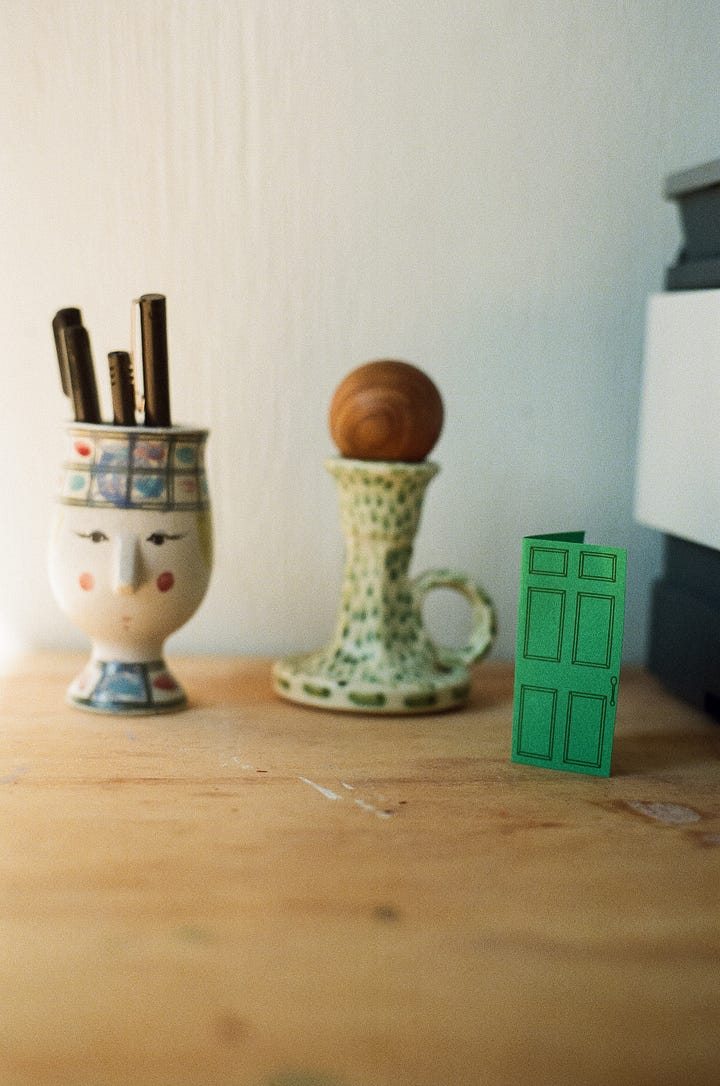
You work in a lot of different mediums. Tile, riso and screen printing, painting huge pieces. How do you decide which medium to apply?
A lot of my practice has to do with similar concepts but seeing how they translate across different mediums. I have always found comfort in watercolor. When I was in high school, my mom met this man tabling at our Jewish community center. He was selling his watercolor paintings. She went up to him and said, all right, you’re going to do weekly watercolor lessons for my kid, and he was like, I don’t really do that kind of thing. And she was like, it’s happening. She’s very assertive. So I took weekly watercolor lessons with Bob Callahan, a fantastic watercolorist. What that meant is I went into his house once a week where he had a little art studio at the edge of the sunroom. I would sit next to him, and I wouldn’t even paint. I would just watch him paint. He would say, what do you want to paint today? He would look up a photo of a temple in Egypt and then we would paint it that day. I was always really confused by it, but I realized now that it was really important. He sort of turned into a grandfather figure to me.
Now I’ve been doing watercolors for over 10 years now. I think the fluidity of it translates to a lot of different mediums. If you look at classic painters, they go through a period where they’re making the same thing over and over and over again. It’s the same idea of growing one specific thought in your head and not just dropping the ball but really seeing the idea through. That’s a big reason why I try so many different things. In college, I think I took every single class you could take. I learned welding, woodworking, weaving, felting, natural dying, and even performance art. Why would you leave any stone unturned?
Tattooing is the new medium, right? How does it feel to be given so much trust by a client as you’re learning?
It’s probably the most vulnerable craft you can do, and I really enjoy connecting with people one on one. I really like when a tattoo experience is personable, and it feels like the artist cares about the artwork and also the person and how it’s going to live on. I feel like my perception of tattoo also translates to my care for color. I have this little tool, and it looks like a tool you’d see at a dentist office. But I have little ink cup and a big color palette, and I can mix specific colors for a tattoo. My favorite part of every tattoo, if there’s color, is mixing the colors with the person. and doing skin tone tests and making sure the person is really excited about the colors. It’s essentially watercolor, and I feel like it translates really closely to painting. It’s been a really lovely way to connect with people.
It’s very clear you have a palette. Celery greens, peachy oranges, sunny yellows. I’m wondering how you developed that.
I work mostly with green. It’s always been my favorite color ever since I could speak. I recently learned that humans can see the most shades of green out of any color, and that has to do with evolution from when we had to deal with predators to see nature more clearly. I think it’s subconsciously a big reason why I love green—I feel so safe in it and it’s the most accessible color. The colors around green often change in my work, but I think I’ve always felt like green is within me. I also only have green tattoos. Growing up, when I felt like my family was the most a family, we lived in a house with a green door. There’s a little paper green door outside the studio (and on the desk). It’s my business card, too. One day it will probably be Green Door Studios, but not yet. Also green is the color of life.
You strike me as someone who’s always creating. I’m wondering if there’s a difference between play, rest, and work for you?
My biggest challenge is learning when I’m doing something for fun versus for work. It’s really easy for me to put all my design work into the box of work. Maybe that’s a good thing because then art feels like play. But then I struggle to push my artwork to be within the more professional world because I don’t necessarily have the confidence to apply to a residency or have a show. It’s all new and I haven’t really had the space to explore it yet. Now that I do, and I can my display work instead of hiding it under my bed, I’m learning a lot about how to push art to the work side. Part of that is having friends in New York, Portland, and around the world that use art as their form of work and profession, and seeing how they do it and asking questions.
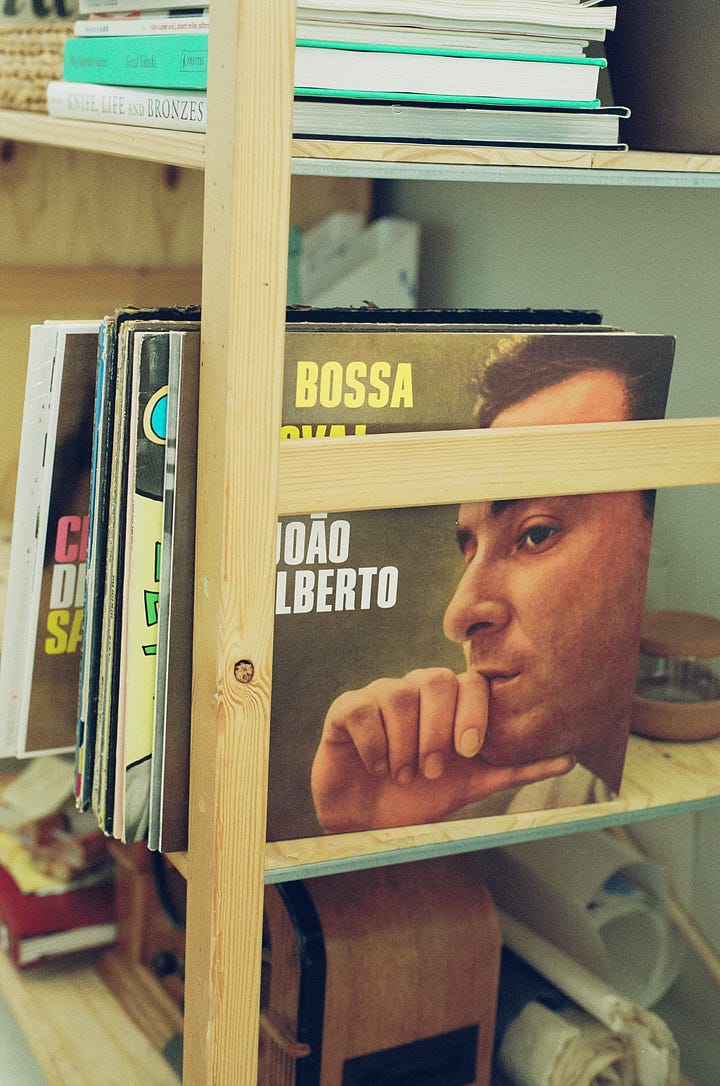

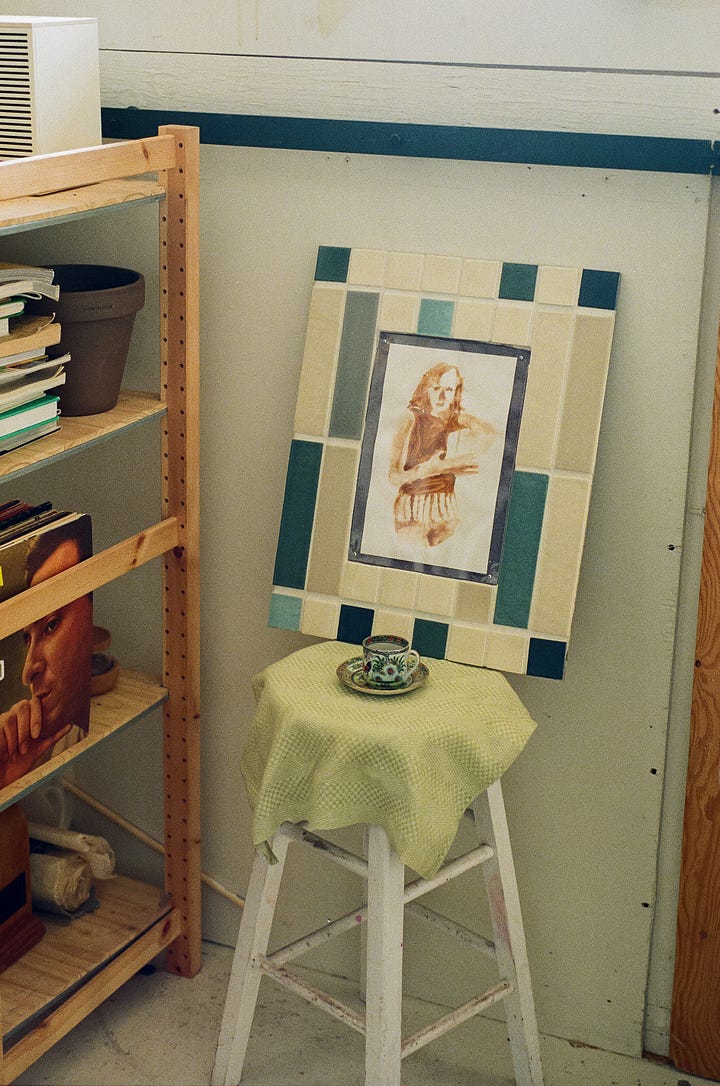
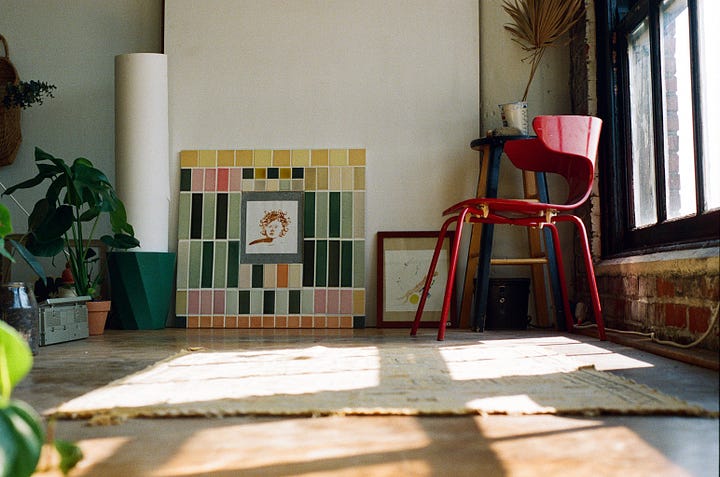
What’s in your bag? “I always have my laptop, my iPad, all my watercolors, and a sketchbook in my bag everywhere I go. I found my green bag on a curb of this nice brownstone in Williamsburg and I wear it everywhere. It was completely new and empty. I think someone just didn’t want it.”
Reading right now: “Ross Gay’s Book of Delights. It’s the perfect book to take somewhere and sit by yourself and enjoy.”
Favorite shade of green: “I really like when there’s a lot of texture with a color. So when I was at the tile, there were a lot of different types of green tile but I really liked one with a weird texture. I often lean to an olive green. I like when there’s yellow tones in there.”
What you’d name a Crayon: “I would probably name it Rigor Mortis. It would be a milky pinkish red. Sorry if that’s creepy.”
Simple pleasures: “Probably a salty snack. My guilty pleasure is I am obsessed with really expensive grocery stores. I used to live above a place in Williamsburg that was a cheese shop, a butcher shop, a sandwich shop, an organic grocery, and a coffee shop, all in one. Now I work at a print shop in Portland called Outlet. It’s right around the corner from Providore. And there’s a cheese store called Cowbell right around the corner from here.”
Auditory input when creating: “When I’m making art, I really need to focus. I either need to have silence or I can only listen to Bossa Nova music. I like music that is either instrumental or I don’t speak the language.”
What are a few items* in your studio that you love?
*See photo above for reference
For my birthday, my friend, Amal, just bought me a pencil case with a cowboy on it. It looks like a guitar. I like it because it’s a lot of different things in one thing, which is how my brain works. I love when I can’t tell if something is new or old, but it’s really beautiful and thoughtful. And you know when the friend you might not always expect gets you the most precious gift does and you learn a lot about that friend and how they see the world? It’s really cute.
This tape measure I got in Manzanita (the wooden ball). I use this for my tattoos to figure out the size of a piece. Then this (the speckled ceramic candlestick), my friend, Kendall, made. I like giving something a purpose that it isn’t supposed to have, so this is the tape measure holder.
And this is a book from the top floor of Powell’s. It’s a book of Swedish graphic design that I bought when my dad was visiting. We geek over graphic design stuff togther. It’s really weird illustrations and really fun colors and style. It’s one of those things that makes you want to cry because you love it so much.
Before we go, we can’t forget to talk about your love of chairs.
I think it has to do with the fact that a chair is everywhere, but it can take so many forms. It’s kind of like people. I’m in this headspace right now where I’m thinking about chairs with human heads on them. So maybe it’s personifying a chair. They’re like my friends. Mia found my favorite chair at a Habitat for Humanity free section. It doesn’t sit flat, and it will fall apart if you jump into it. If you sit normal in it, it’s fine.
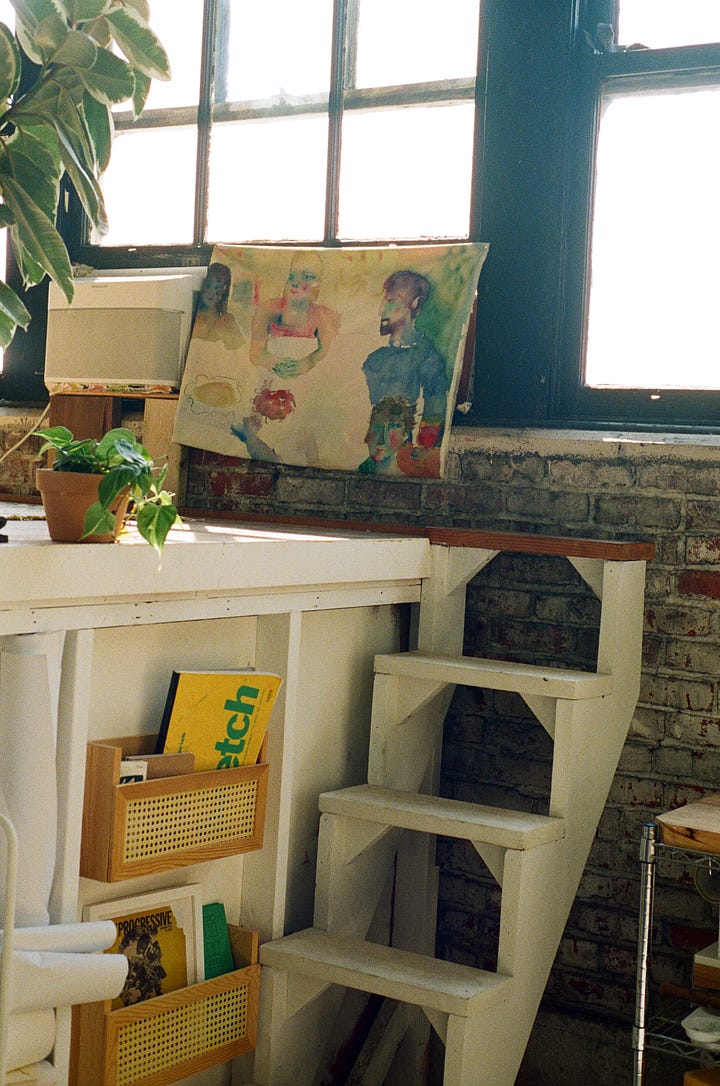
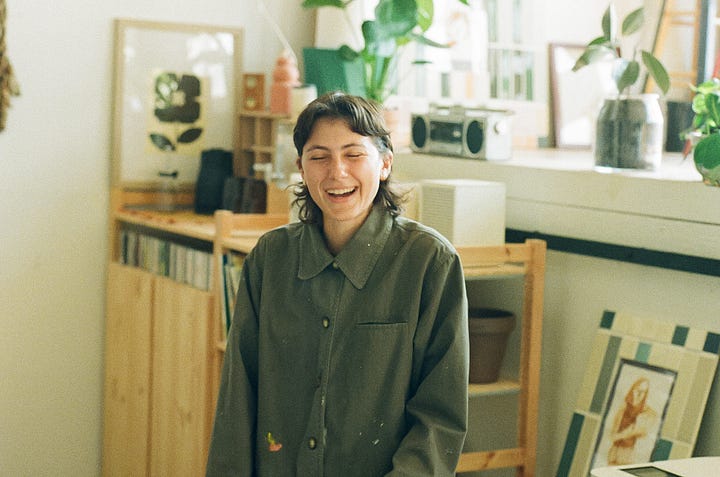
Where you can find Zab | Website | Instagram | Sosta House
Amelia Arvesen (she/her) is the creator of Honing Her Craft and a freelance journalist who integrates her artistic side into her every day. The STUDIO VISITS series merges her curiosity as an interviewer with her admiration of creative practices and people.
Lauren Beane (she/her) is a freelance photographer specializing in film. She values a life centered around art, nature, community, and little pleasures. This series allows her to expand her definition of what it means to live a creative, artful life while providing others a window to do the same.
You can find previous editions of STUDIO VISITS here. Support this series by liking it, forwarding it, or upgrading to a paid subscription.

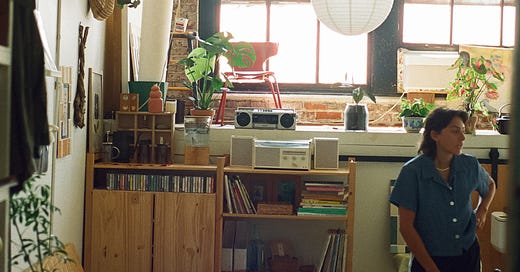



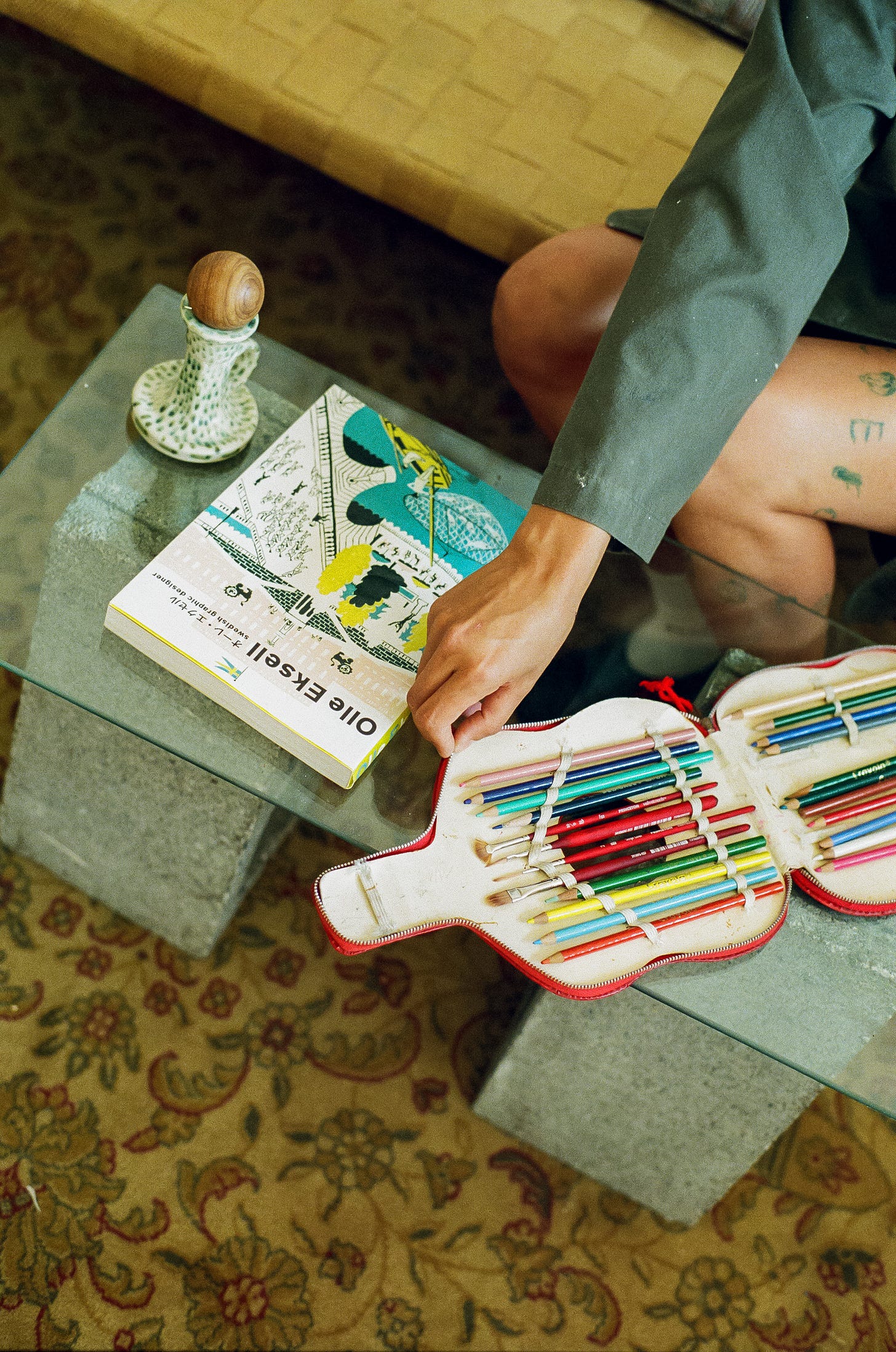
love this and the fact about seeing humans seeing the most shades of color in green is somehow so grounding :')
love this!!! zab is the coolest. <3